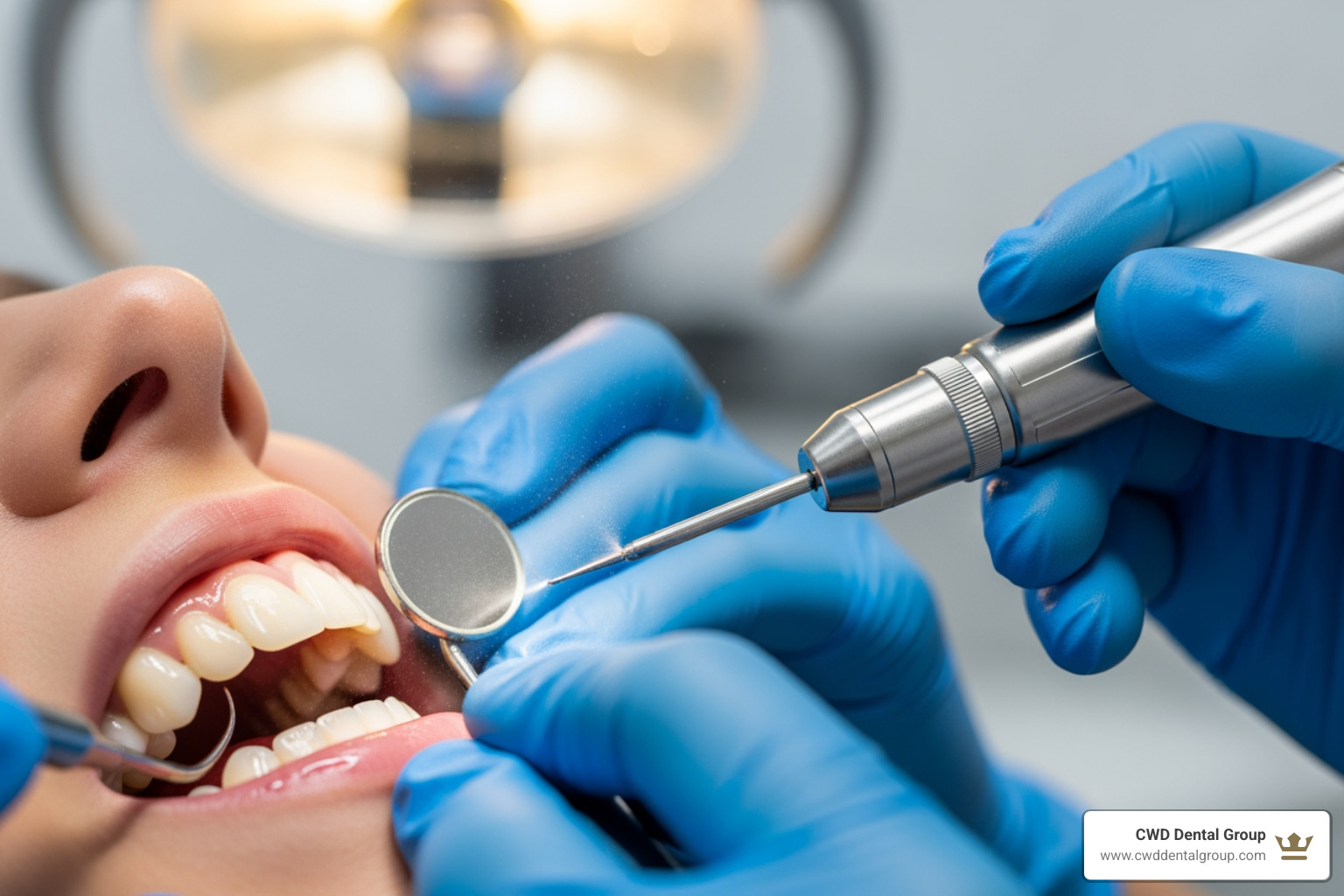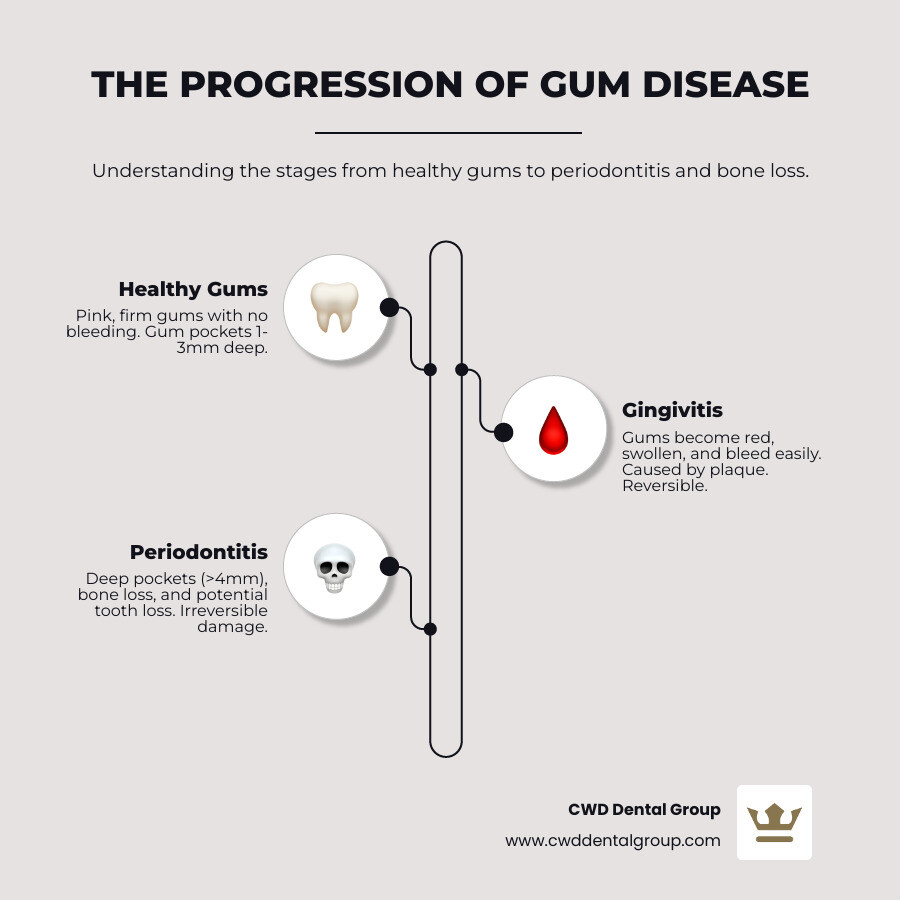Deep Scale Cleaning Demystified: What to Expect from Your Dentist
Understanding the Scale of Teeth and Why It Matters

Scale of teeth, also known as dental scaling, is a deep cleaning procedure that removes plaque and tartar (calculus) from below the gumline to treat gum disease. Unlike regular cleanings that focus on visible tooth surfaces, scaling targets bacterial buildup in the pockets between your gums and teeth—areas your toothbrush can't reach.
Quick Answer: What is Teeth Scaling?
- What it is: A professional dental procedure to remove hardened plaque (tartar) from above and below the gumline.
- Why it's needed: To treat gum disease (gingivitis or periodontitis) when regular cleanings are not enough.
- How it works: Dental professionals use specialized tools to scrape away deposits and smooth tooth roots.
- When it's recommended: For gum pockets deeper than 4mm, bleeding gums, or other signs of periodontal disease.
- Who performs it: Dentists, dental hygienists, or periodontists.
Nearly half of American adults have some form of gum disease, and chronic periodontitis affects 47.2% of adults over 30 in the United States. Left untreated, gum disease is a leading cause of tooth loss for adults. The good news is that a deep scale cleaning can halt its progression and help your gums heal.
Many people don't realize the difference between a regular cleaning and this therapeutic deep cleaning. Some have even seen viral videos suggesting you can scale your own teeth at home—a dangerous idea that can lead to serious damage.
I'm Kayle Vernon, and my expertise is in helping dental practices like CWD Dental Group explain complex procedures like the scale of teeth in clear, accessible terms. Understanding your dental care is the first step toward healthier gums.

What is Scaling and Root Planing (and Why You Might Need It)?
Think of your daily brushing and flossing as routine house cleaning. But sometimes, grime builds up in hard-to-reach places. When this happens below your gumline, it's a genuine health concern.
Plaque buildup is where the trouble starts. This sticky film of bacteria constantly forms on your teeth. If not removed, it hardens into calculus—better known as tartar. Unlike soft plaque, tartar is rock-hard and can only be removed by a professional. Its rough surface attracts even more plaque, creating a vicious cycle.
When tartar accumulates below the gumline, it irritates the gum tissue, leading to gum inflammation (the hallmark of gingivitis). You may notice red, tender, or bleeding gums. At this early stage, gingivitis is reversible with a professional cleaning and improved home care.
If left untreated, gingivitis can advance to periodontitis, a more aggressive form of gum disease. The chronic inflammation causes gums to pull away from the teeth, forming periodontal pockets. These pockets become breeding grounds for bacteria, plaque, and tartar that you can't reach.
As the infection deepens, the bacteria attack the bone and tissue that anchor your teeth. This bone loss is often silent, and you might not notice it until your teeth feel loose. Eventually, this can lead to tooth loss, not from cavities, but from a lack of support.
According to research in the Journal of the American Dental Association, this condition affects nearly half of American adults over 30. This is why the scale of teeth procedure—formally called scaling and root planing—is so important. It’s a therapeutic deep cleaning designed to stop the infection hiding below your gumline.
The Goal of a Deep Cleaning
A deep cleaning has specific therapeutic goals:
- Treating gum disease by eliminating the source of the infection (bacteria, plaque, and tartar).
- Preventing tooth loss by halting the destruction of the bone and tissue that support your teeth.
- Promoting gum reattachment by smoothing the tooth roots, creating a clean surface for gums to heal and reattach.
- Reducing pocket depth by helping inflamed gums shrink back to a healthier, more cleanable state (1-3 millimeters).
Signs You Need a Deep Cleaning
While only a dental professional can make a diagnosis, these warning signs suggest it's time for an evaluation at CWD Dental Group:
- Bleeding gums when you brush, floss, or eat.
- Swollen or tender gums that are red and puffy instead of firm and pink.
- Persistent bad breath that doesn't improve with brushing or mouthwash.
- Receding gums, which make your teeth look longer and expose sensitive roots.
- Deep gum pockets measuring 4 millimeters or more, which a dental professional finds during an exam.
If you're experiencing these symptoms, don't wait. Early treatment leads to better outcomes. Visit our periodontal care services page or schedule a consultation with our team at CWD Dental Group.
The Deep Cleaning Procedure: A Step-by-Step Guide
If you're nervous about a "deep cleaning," know that it's a routine procedure our skilled team at CWD Dental Group performs regularly with your comfort as our top priority.
The procedure is performed by our experienced dental hygienists or dentists, and in complex cases, by a gum specialist (periodontist). The entire process usually takes one to two hours. We often work on one half or quadrant of your mouth at a time, sometimes splitting the treatment into two appointments for your comfort.

Step 1: Examination and Numbing
First, we use a small tool called a periodontal probe to measure the depth of the pockets around each tooth. This map of your gums tells us exactly where the scale of teeth is needed, focusing on pockets 4 millimeters or deeper.
Next, we ensure you're comfortable by applying a local anesthetic to numb your gums and surrounding tissue. You shouldn't feel any pain during the procedure, just some pressure or movement. Your comfort is our priority, so please let us know if you need anything.
Step 2: Scaling Below the Gumline
This is the core of the procedure, where we remove all the plaque and tartar from your tooth surfaces, especially below the gumline.
We use two types of tools for a thorough job. Ultrasonic scalers use high-frequency vibrations and a stream of water to break up and wash away stubborn tartar and bacteria from deep pockets. For fine-tuning, we use manual scalers (curettes), which are hand-held instruments that allow for precise removal of any remaining deposits.
We methodically clean each tooth surface down to the bottom of the periodontal pocket. This deep, targeted cleaning is what separates this procedure from a regular checkup.
Step 3: Smoothing the Roots (Root Planing)
After scaling, we perform root planing—smoothing the surfaces of your tooth roots. This is a critical step for healing.

Rough root surfaces attract bacteria, so smoothing them creates a clean slate. During root planing, we are removing bacterial toxins embedded in the root and creating a smooth surface. This makes it much harder for new plaque to attach.
Most importantly, a smooth, clean root surface helps your gums heal and reattach firmly to your teeth. This process reduces pocket depths and creates a tighter seal, protecting your teeth from future infection. Root planing is what makes this a truly therapeutic procedure, setting the stage for your gums to recover their health.
Regular Cleaning vs. The Deep Scale of Teeth: What's the Difference?
Is a deep cleaning just a more intense regular cleaning? It's a common question we hear at CWD Dental Group. While both remove plaque and tartar, they serve very different purposes.
A regular cleaning is preventive maintenance for a healthy mouth. A deep cleaning is a therapeutic treatment to fix an active problem.
Here's a clear comparison:
| Feature | Regular Dental Cleaning (Prophylaxis) | Deep Cleaning (Scaling and Root Planing) |
|---|---|---|
| Purpose | Preventive: Maintain oral health, remove plaque/tartar from healthy teeth. | Therapeutic: Treat active gum disease (periodontitis) by removing infection sources. |
| Depth | Supragingival: Focuses on tooth surfaces above the gumline. | Subgingival: Extends deep below the gumline, into periodontal pockets, and onto tooth roots. |
| Conditions | Healthy gums or very mild gingivitis. | Moderate to severe gingivitis, chronic periodontitis with periodontal pockets (4mm+). |
| Anesthesia | Generally not required. | Often required to ensure patient comfort due to working below the gumline. |
| Frequency | Typically biannual (every six months) for most patients. | Usually a one-time treatment per affected area, followed by more frequent periodontal maintenance (3-4 months). |
| Outcomes | Prevents cavities and gingivitis, maintains fresh breath, keeps teeth clean. | Halts disease progression, reduces inflammation, promotes gum reattachment, prevents tooth/bone loss. |
Regular Dental Cleaning (Prophylaxis)
A regular cleaning, or prophylaxis, is for maintaining good oral health. If your gums are healthy (firm, pink, with pocket depths of 1-3 millimeters), this is the cleaning you'll receive.
During a prophylaxis, our hygienists focus on cleaning above the gumline (supragingival), removing plaque and tartar from visible tooth surfaces. This preventive care, typically recommended every six months, is your best defense against cavities and early gum disease.
Deep Cleaning (Scaling and Root Planing)
A deep cleaning—the scale of teeth procedure—is a targeted treatment for active gum disease. When you have periodontitis with inflamed gums and pockets 4 millimeters or deeper, a regular cleaning can't solve the problem.
Scaling and root planing goes below the gumline (subgingival) to thoroughly clean the tooth roots inside these deep pockets. We typically use local anesthesia to ensure your comfort. Think of it this way: a regular cleaning is like wiping your counters, while a deep cleaning is like scrubbing behind the appliances to eliminate hidden grime.
After a deep cleaning, you'll need more frequent follow-up appointments (periodontal maintenance) every three to four months to maintain your gum health. For more information, visit our page on periodontal services. The good news is that this treatment can stop the disease, help your gums heal, and prevent serious consequences like tooth loss.
Benefits, Risks, and Post-Procedure Care
Choosing a deep cleaning is an investment in your long-term health. It's important to understand the benefits, potential side effects, and how to care for your mouth afterward.
Key Benefits of a Deep Cleaning
The positive effects of scaling and root planing become clear as your gums heal.
- Halts gum disease progression: By removing bacteria below the gumline, we stop the disease from destroying more gum tissue and bone.
- Reduces inflammation: Your gums will become less red, swollen, and tender. Bleeding during brushing should significantly decrease or stop entirely.
- Fresher breath: Eliminating bacteria trapped in deep pockets removes the source of persistent bad breath.
- Prevents tooth and bone loss: Saving the structures that anchor your teeth helps you keep your natural smile and avoid more complex treatments like implants or dentures.
- Improves overall health: Reducing harmful oral bacteria can positively impact your systemic health, as gum disease is linked to conditions like heart disease and diabetes.
Potential Risks and Side Effects
While scaling and root planing is safe and effective, some temporary side effects are possible.
- Temporary sensitivity: It's normal for teeth to be sensitive to hot or cold for a few days or weeks. A desensitizing toothpaste can help.
- Minor bleeding: Some light bleeding for a day or two after treatment is a normal part of the healing process.
- Gum recession: As swelling subsides and gums tighten, they may appear slightly lower. This is a sign of healing, not new damage.
- Discomfort: Mild soreness in the gums for a day or two is common and can be managed with over-the-counter pain relievers like ibuprofen.
- Risk of infection (rare): We take every precaution to prevent infection. In some cases, we may recommend an antibiotic rinse or place antibiotics directly in the cleaned pockets.
Aftercare and Recovery Following a Deep Scale of Teeth
Your role in recovery is crucial for long-term success.

- Eat a soft food diet for the first day or two. Think yogurt, smoothies, and scrambled eggs. Avoid extreme temperatures in food and drinks.
- Practice gentle oral hygiene. Continue to brush and floss, but be extra gentle around the treated areas as instructed.
- Use saltwater rinses. Gently swishing with warm salt water (half a teaspoon of salt in a glass of water) several times a day can soothe gums and promote healing.
- Attend follow-up appointments. These visits are essential for us to monitor your healing, check pocket depths, and ensure the best long-term results.
Most patients return to their normal routines the same day. By following these guidelines, you'll be on the fast track to healthier gums.
Frequently Asked Questions about Dental Scaling
It's normal to have questions about a deep cleaning. Here are clear, honest answers to some of the most common concerns we hear at CWD Dental Group.
How often is scaling and root planing needed?
Good news: scaling and root planing is not a routine procedure. It's a specific treatment for active gum disease.
After your deep cleaning, the focus shifts to maintenance. You'll likely transition to "periodontal maintenance" appointments every three to four months instead of the standard six. These more frequent visits allow us to keep a close eye on your gum health, remove any new buildup, and prevent the disease from returning. We'll work with you to create a personalized schedule based on your specific needs and how your gums respond to treatment.
Can I perform a scale of teeth at home?
We must be clear: absolutely do not attempt to scale your own teeth at home. While DIY dental tool kits are available online, using them without professional training is extremely dangerous.
The risks are serious and can cause permanent damage. You can easily scratch your tooth enamel, injure your delicate gums, or accidentally push bacteria deeper into the gum pockets, making the infection worse. Furthermore, home tools are not sterile and can introduce harmful bacteria into your mouth.
Safe, effective scaling requires years of training to understand dental anatomy and apply the correct techniques. In areas like Tallahassee, Havana, and Quincy, professional care is accessible. Please do not risk your oral health with DIY attempts. Professional expertise is required.
Does a deep cleaning hurt?
This is a top concern for many patients. The answer is that the procedure itself should not hurt.
We use local anesthesia to numb the areas we're working on, just like for a filling. You may feel some pressure or vibration, but you shouldn't feel pain. Our team is dedicated to ensuring you are comfortable throughout the process.
After the anesthetic wears off, you may have some post-procedure soreness or tenderness for a day or two. Temporary tooth sensitivity to hot or cold is also normal. This discomfort is manageable with over-the-counter pain relievers like ibuprofen. We will also provide aftercare instructions, such as saltwater rinses and a temporary soft food diet, to minimize discomfort and aid healing.
If you feel anxious, please talk to us. We can discuss additional comfort options to ensure you feel at ease.
Conclusion: Taking the Next Step for Healthier Gums
By now, you know that the scale of teeth is more than just a cleaning—it's a powerful therapeutic procedure that can halt gum disease and protect your oral health.
Nearly half of American adults have some form of gum disease, often without realizing it. Symptoms like bleeding gums or persistent bad breath are your body's way of asking for help. The good news is that effective help is available.
Scaling and root planing halts the progression of gum disease, promotes healing of your gums, and prevents tooth loss. It saves you from the burden of more complex and costly treatments down the road and gives you back the confidence to smile freely.
At CWD Dental Group, our philosophy is simple: provide exceptional, patient-centered care. We understand dental anxiety is real, which is why we take the time to explain everything and ensure your comfort. We are proud to care for our neighbors in Tallahassee, Havana, Quincy, Crawfordville, and Wakulla, Florida.
Your oral health is deeply connected to your overall well-being. Addressing gum disease is one of the best investments you can make in yourself. Whether you have symptoms or it's just been a while since your last check-up, now is the time to take action.
Don't let gum disease progress silently. Our experienced team is ready to create a personalized plan for you. Schedule a consultation for your dental health with us today, and let's work together to protect your smile for years to come.
